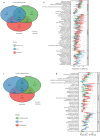Metagenomic and metatranscriptomic analysis of saliva reveals disease-associated microbiota in patients with periodontitis and dental caries
- PMID: 28979798
- PMCID: PMC5624903
- DOI: 10.1038/s41522-017-0031-4
Metagenomic and metatranscriptomic analysis of saliva reveals disease-associated microbiota in patients with periodontitis and dental caries
Abstract
The taxonomic composition of the salivary microbiota has been reported to differentiate between oral health and disease. However, information on bacterial activity and gene expression of the salivary microbiota is limited. The purpose of this study was to perform metagenomic and metatranscriptomic characterization of the salivary microbiota and test the hypothesis that salivary microbial presence and activity could be an indicator of the oral health status. Stimulated saliva samples were collected from 30 individuals (periodontitis: n = 10, dental caries: n = 10, oral health: n = 10). Salivary microbiota was characterized using metagenomics and metatranscriptomics in order to compare community composition and the gene expression between the three groups. Streptococcus was the predominant bacterial genus constituting approx. 25 and 50% of all DNA and RNA reads, respectively. A significant disease-associated higher relative abundance of traditional periodontal pathogens such as Porphyromonas gingivalis and Filifactor alocis and salivary microbial activity of F. alocis was associated with periodontitis. Significantly higher relative abundance of caries-associated bacteria such as Streptococcus mutans and Lactobacillus fermentum was identified in saliva from patients with dental caries. Multiple genes involved in carbohydrate metabolism were significantly more expressed in healthy controls compared to periodontitis patients. Using metagenomics and metatranscriptomics we show that relative abundance of specific oral bacterial species and bacterial gene expression in saliva associates with periodontitis and dental caries. Further longitudinal studies are warranted to evaluate if screening of salivary microbial activity of specific oral bacterial species and metabolic gene expression can identify periodontitis and dental caries at preclinical stages.
Conflict of interest statement
The authors declare that they have no competing financial interests.
Figures





References
LinkOut - more resources
Full Text Sources
Other Literature Sources

